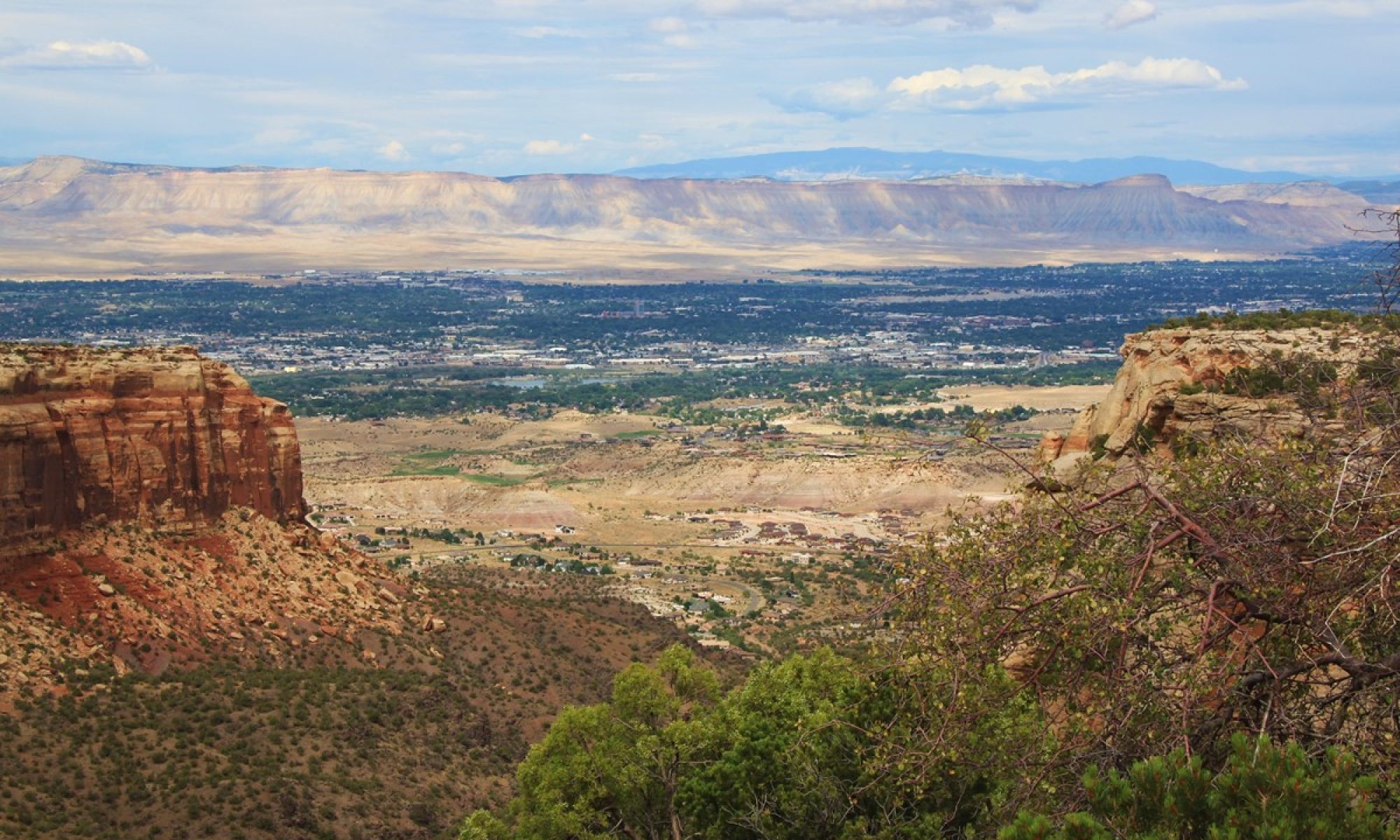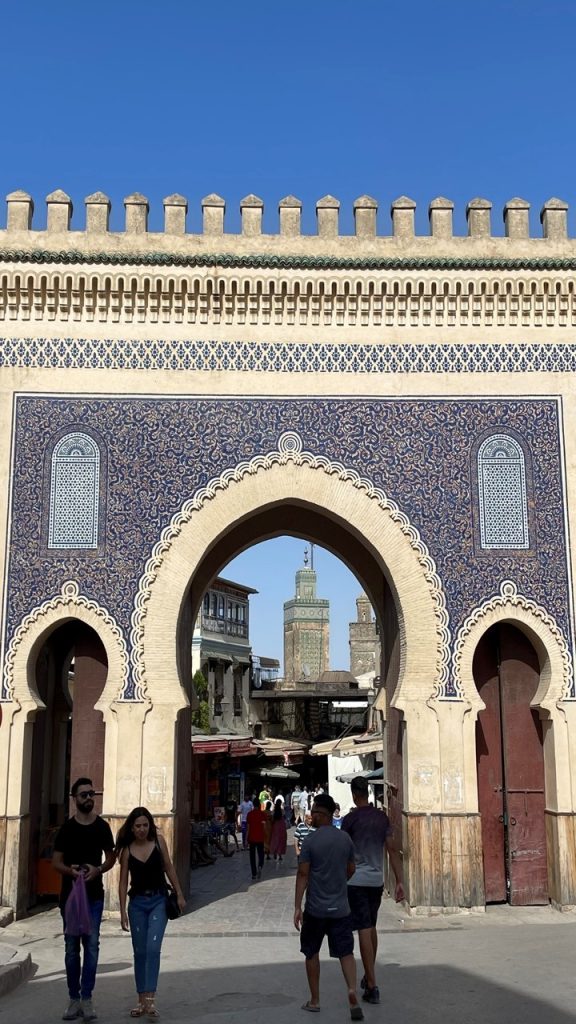Fez
Monday morning, after breakfast, we checked out of our hotel and boarded our bus for the 5-hour trip to the city of Fes (Fez in English). We leave the coast, pass the Palace of Dar es Salaam along with sweeping fields, rolling countryside, and tree-covered slopes, mostly covered with rows of olive trees. We use the time to discuss Morocco’s King Mohamed VI, a relatively young man at 58-years-old, who is not in the best of health. He was educated and holds a PhD in Law from Nice, France, and ascended to the throne upon his father’s, King Hassan II, death in 1999. He holds enormous wealth as the richest king in Africa and the 5th richest king in the world, but in 2004 he led very progressive reforms in the areas of universal health, education, and women’s rights.
After an hour-and-a-half, we stopped for refreshments at a vegetable market in a city called El Khemisset. Here, we walked through the fresh vegetable market and learned about the Moroccans tradition of having couscous on Fridays. Fruits and vegetables exported to Europe, along with international tourism, provide the country’s main source of income. As we leave El Khemisset, the police have a checkpoint and stop us to ensure we are wearing or face masks, and to check the vehicle’s recorder to make sure that our driver is taking his required breaks, (15-minutes every 2-hours), and that we have not exceeded the speed limit. Every vehicle in Morocco is fitted with a paper-disc chart recorder that is recording the vehicle’s speed continuously. Driver’s must provide these upon request and can be ticketed, or worse, if found to be in violation of traffic laws.
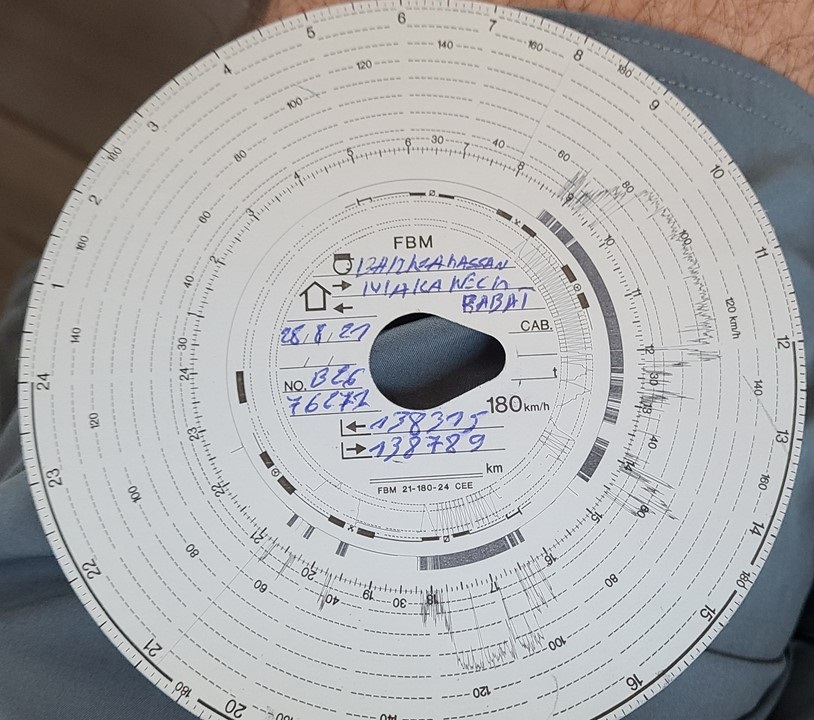
After another hour’s travel, we enter Fes, a city of over 2-million people and the intellectual, spiritual, and handicraft capital of the country. 60% of Moroccan’s now live in a Moroccan city, and the rural farms and countryside are being rapidly gobbled-up by large, industrial companies. Fes dates to the 9th Century and was built around the Al-Qarawiyyin Mosque founded by an Arab woman, Fatima Al-Fihriyy. The Al-Qarawiyyin mosque subsequently developed a teaching institution, which became the University of al-Qarawiyyin in 1963.
After entering the town’s medina, we exit our bus to walk down a maze of small passageways to our accommodations for the next 3 nights – the Riad Palais Marjana. A “riad” is actually the “green-space” within the center of a corresponding residence, and this beautiful Riad, decorated with intricate mosaic tile and detailed plaster carving, has been in the same family for 11 generations and offers only 20 rooms. After checking-in to our modest 2nd-floor room, we met everyone in the riad for lunch – a series of cold salads of beans, carrots, cucumbers, beets, lettuce, and potatoes with rice, with a main course of Kefta Mkaouara – a meatball tagine dish that was delicious – followed by a ktifa – a traditional Moroccan dessert sometimes called “milk bastille”.

After lunch, we met our local guide – another Mohamed – and went to the “Bori Suud” – the Southern Tower, whose design was inspired by that of Portuguese castles. The fortification dates back to the era of the Saadi state, where Sultan Ahmed Al-Mansur ordered its construction in 1582 for defensive military purposes. Later, during French rule, it was used as a prison, and in 1963 it was converted into a weapons museum. It is located south of Fez Al-Bali and was built on a rocky elevation that overlooks the city, called the “Tar Stone”. Facing it on the other side of the city is the corresponding defensive Northern Tower, both offering spectacular panoramic views of the city of Fes! Mohamed then took us to visit a local ceramic manufacturing co-op, and then for a walk along the city’s main street, Hassan II Boulevard. In the center of the boulevard is a popular linear park where stand the symbol and mascot of the country – the Atlas Lion. Today, the Atlas Lion is extinct in the wild, but is kept protected in the country’s zoos. We then returned to our riad for a brief rest, before the two of us ventured out on our own to explore the local area, visit the famous “Blue Gate”, shop, and eat Italian gelato.
The next morning, after breakfast, we again met up with our local guide, Mohamed, and set off to visit the Royal Palace of Fez, (Dar al-Makhzen), and its seven copper doors.
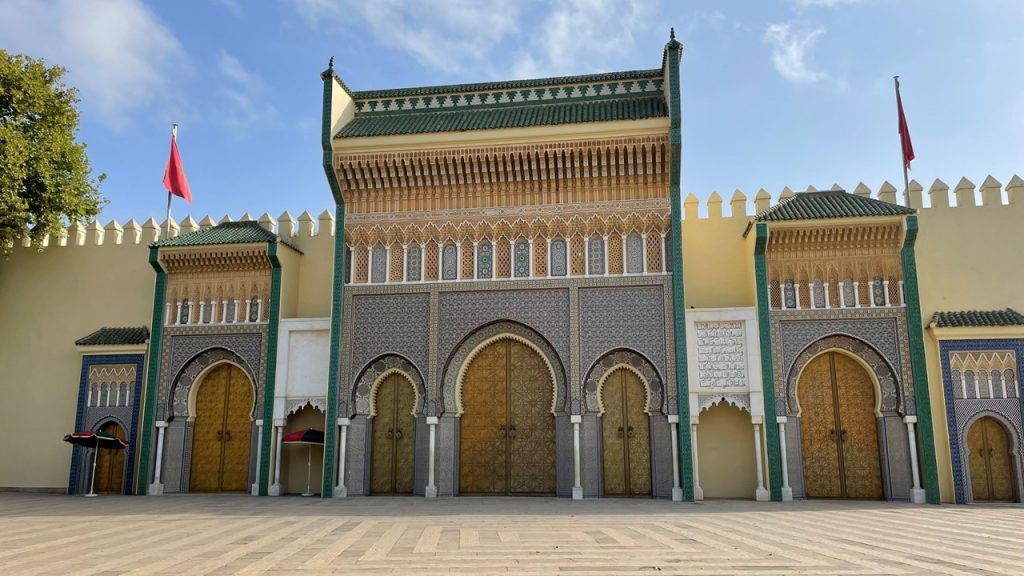
Then we walked through the Jewish quarter of the medina, which is called Mellah, meaning “salt” in Arabic, due to the saline water source and salt warehouse in the area. From there, we began our exploration of the medina’s souks (markets), beginning at the Bad Erracif entrance. We walked through the vegetable, butcher, and fish markets, we dodge donkey carts and motorbikes, making our way along the ~7000 narrow passages, before arriving at the dyers’ market, and then the copper-makers market, (called Esaffarine).
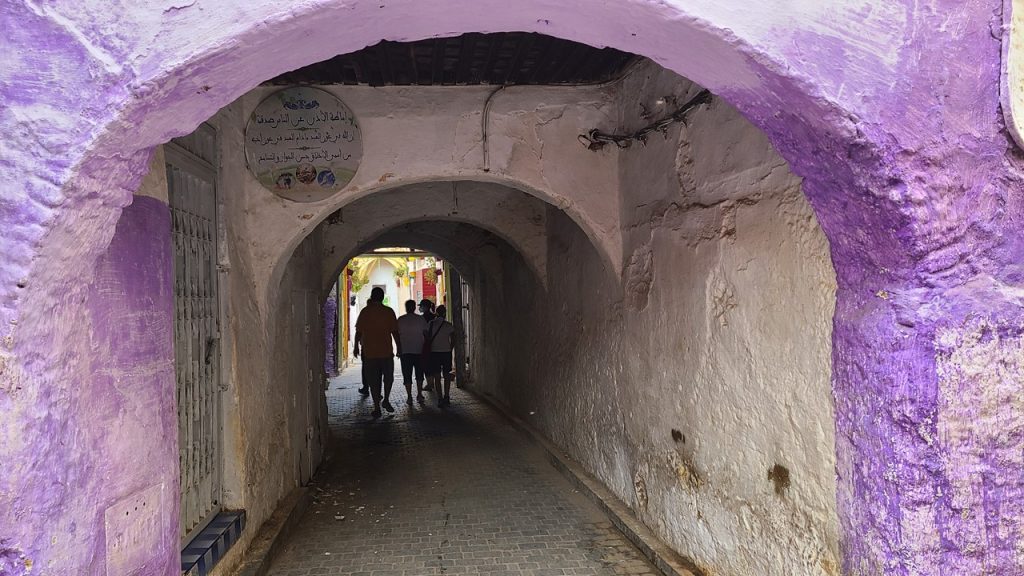
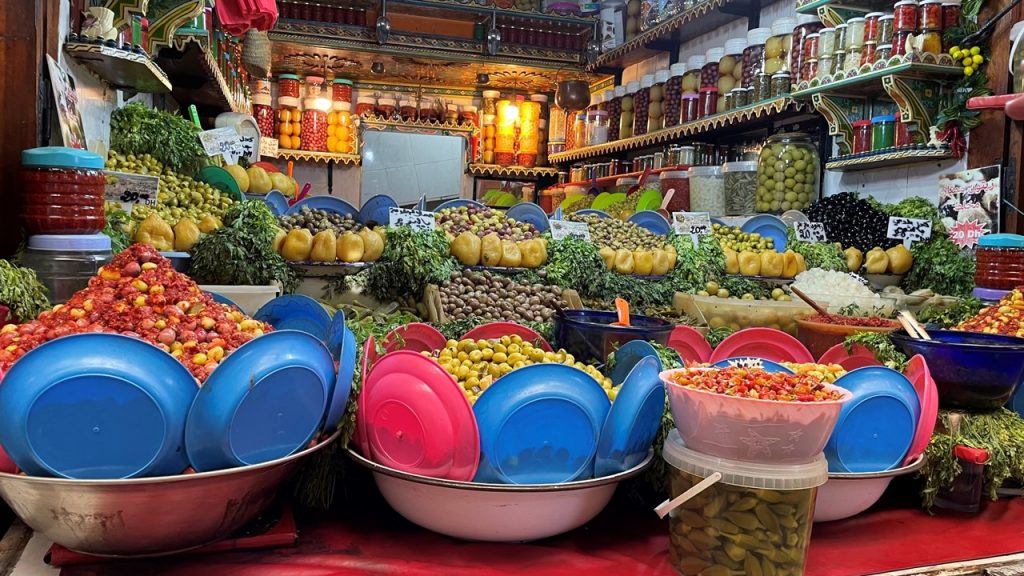
At the copper-makers market, we found a small restaurant where we climbed to the second floor for tea and cookies. Then we continued our walk until we came to Nejjarine’s, our restaurant for lunch – a lemon chicken tagine. The restaurant was named for the carpentry activities that are done in that part of the medina. After lunch, we continued our tour by visiting a Koranic school, (Al Atterine Madrassa), that dates back to the 14th century.
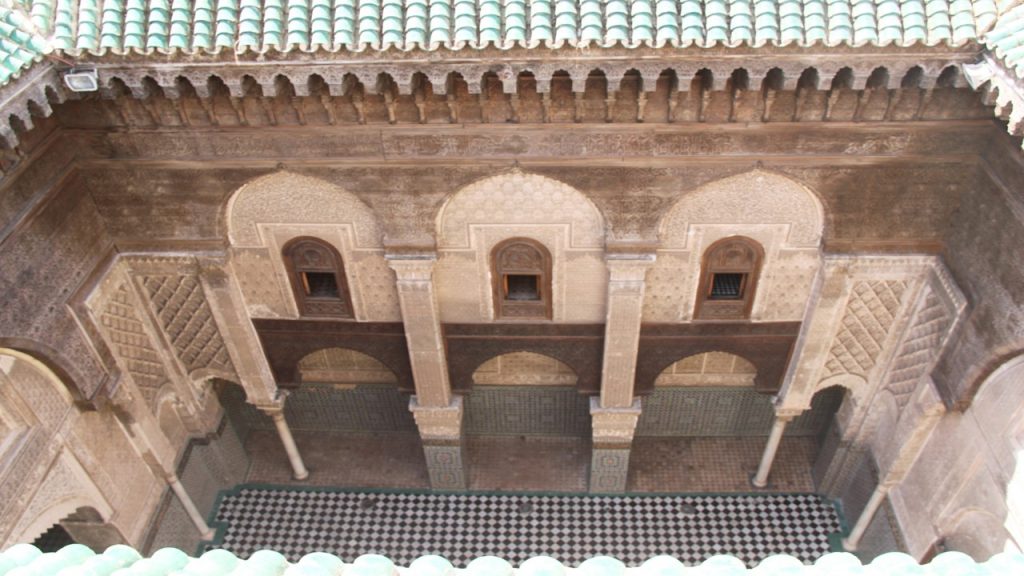
We also visited the famous Terrase de Tannerie tannery of Fes that day, where we climbed to an overlook of the tanning and dye pots that have been in use for centuries. After learning the differences between cow, sheep, and goat hides, we walked to the Mosque and oldest University in the world that was built by Fatima Al Fihria in 859AD. The University is called “Al Quaraouiyine” and the “hand of Fatima” symbol is revered and reproduced on many entrances all around the country. We then finished our tour by visiting the weavers in the Caravan Serai which in Arabic is called a Fondouk. Fondouk’s were built as rest stops for travelers on journeys and can be found along most well-known ancient trade routes. They provided travelers, traders and missionaries with shelter and supplies and served as platforms for communication and exchange between diverse passersby. They were traditionally built in a square or rectangular shape, around an inner courtyard, and often feature a fountain to shelter guests from the heat.
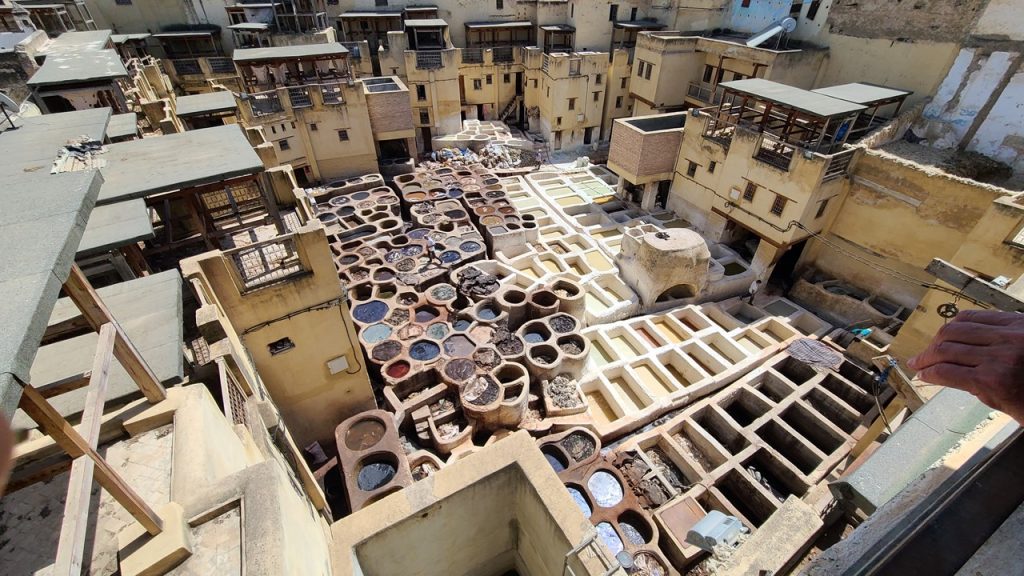
After our tour, we returned to our riad to prepare to meet our home-hosting family for dinner.
Our hosting began when the family’s 21-year-old daughter, Kawtar, came and walked us a short distance to their home – a spacious 2nd-floor flat where she, her parents and her 16-year-old sister lived. Their 26-year-old brother had already received his degree in France and was working there as an electrical engineer. Dad was a banker who spoke little English, but Kawtar translated easily to French for him. The family’s mother, Fatima, also held a degree, but had given up her career to raise her family. Little sister, Hiba, is preparing for exams to progress her on a road to a future medical degree. Kawtar was preparing to leave home in a matter of days to follow her brother and travel to France to study for a master’s degree in Finance. Like any family who wants a better life for their children, the parent’s see education as the path to the next generation’s happiness and success. We talked about careers (ours and theirs), the pandemic, travel, and children. We even talked a little about Moroccan politics since their elections were only a day away. We all had dinner of harira soup with bread and figs, and a delicious lamb tagine with caramelized prunes. At the end of the night, after heartfelt thanks and goodbyes, we had to hurry back to our riad to beat the 9:00pm curfew.
Wednesday morning the travel group split, and while the other 3 traveled to visit nearby Roman ruins, we took the option to take a cooking class learning to make our own tagine. A young woman, Amine, met us at our riad and took us on an hour-long shopping walk to the local souk located near to the famous “Blue Gate”. Making our way through the bustling market, we purchased eggplants, onions, green peppers, tomatoes, carrots, olives, and everything we would need to cook lunch.
From there, we returned to nearby Riad Salam where a cooking cart was set up for us next to the pool in the center of the riad. We met our Moroccan instructor, the Riad’s chef, and she took us through the prepping and cooking for making a Lemon Chicken tagine. We used the eggplant to make Zaalaouk, an eggplant & tomato salad, and the peppers to make Taktouka, another tasty salad, and then, while finishing the cooking, we enjoyed mint tea and anise cookies. After the lunch was completed, we dined at an elegant setting, and finished with a dessert of Jawhara – fried filo pastry stacked with panna cotta.
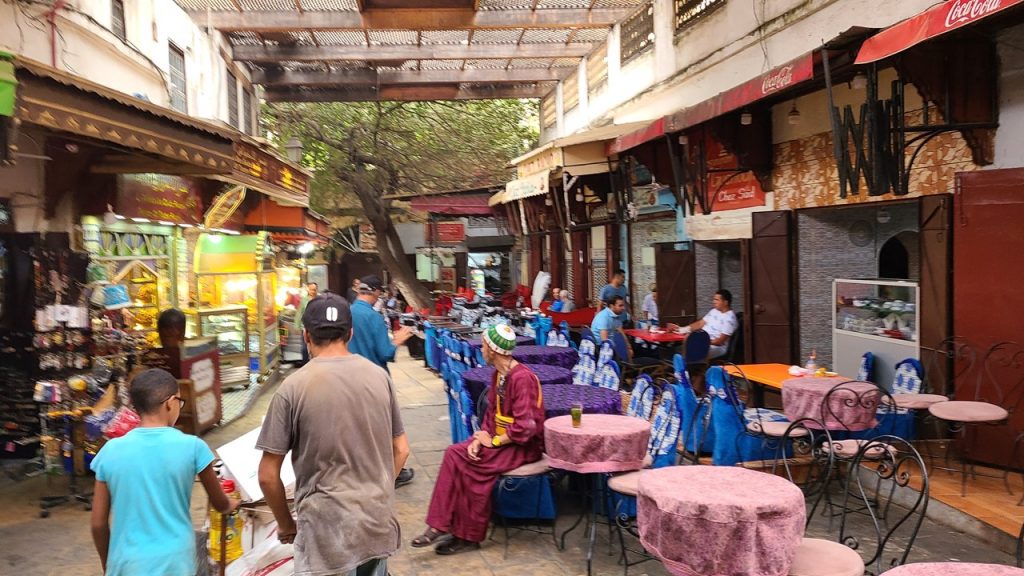
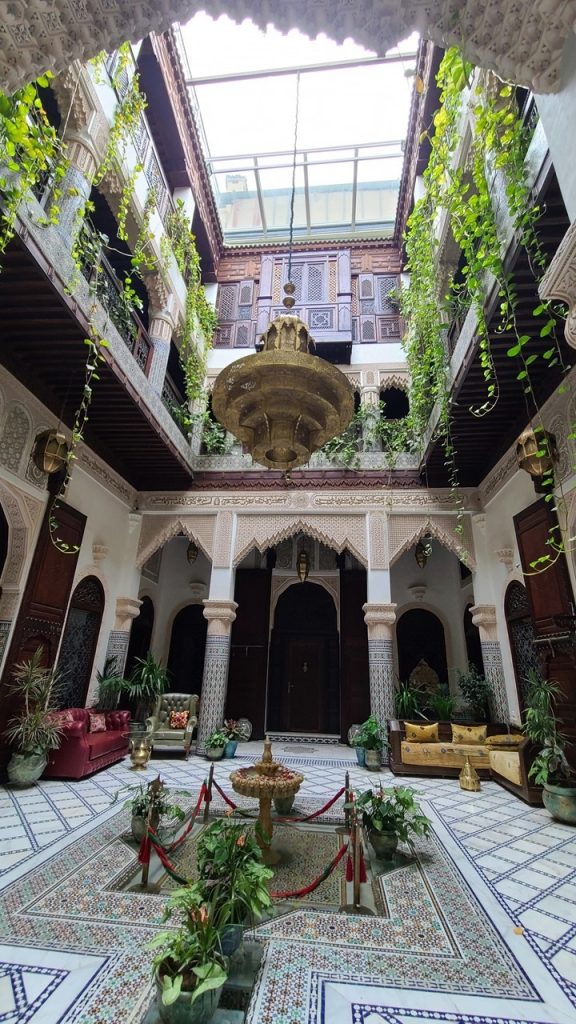
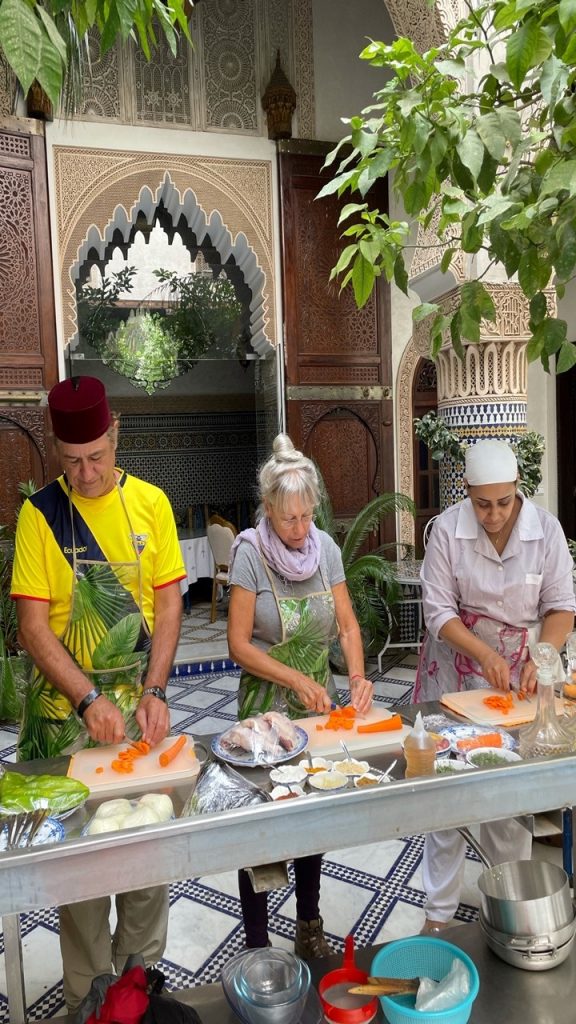
We leisurely returned to our riad by 3:00pm where we met up with our returning tour-mates. From there, we assembled for a short walk to International Institute for Languages and Culture where we met with Women’s Rights Author, Professor Fatima Sadiqui. We engaged in a discussion on her views of the impact of conservative Moroccan culture on women’s rights and discussed changes which are driving the country forward. After our lively conversation, we headed back to our riad for a dinner of chicken pasilla – a sweet & savory chicken filling that is wrapped in layers of very thin dough.
